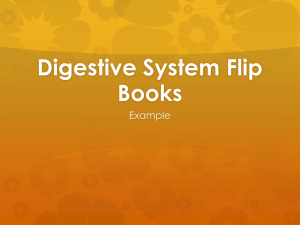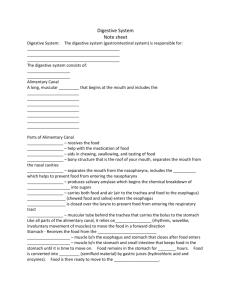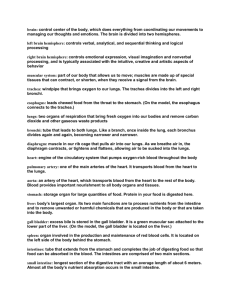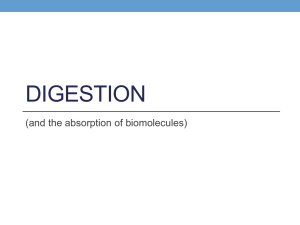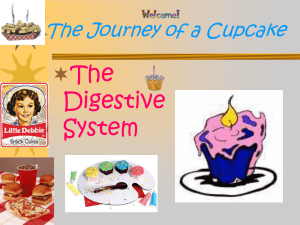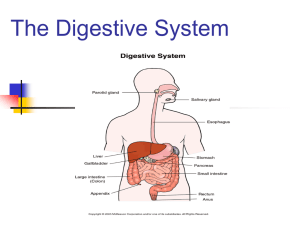Food is about more than just filling us up. As we
advertisement
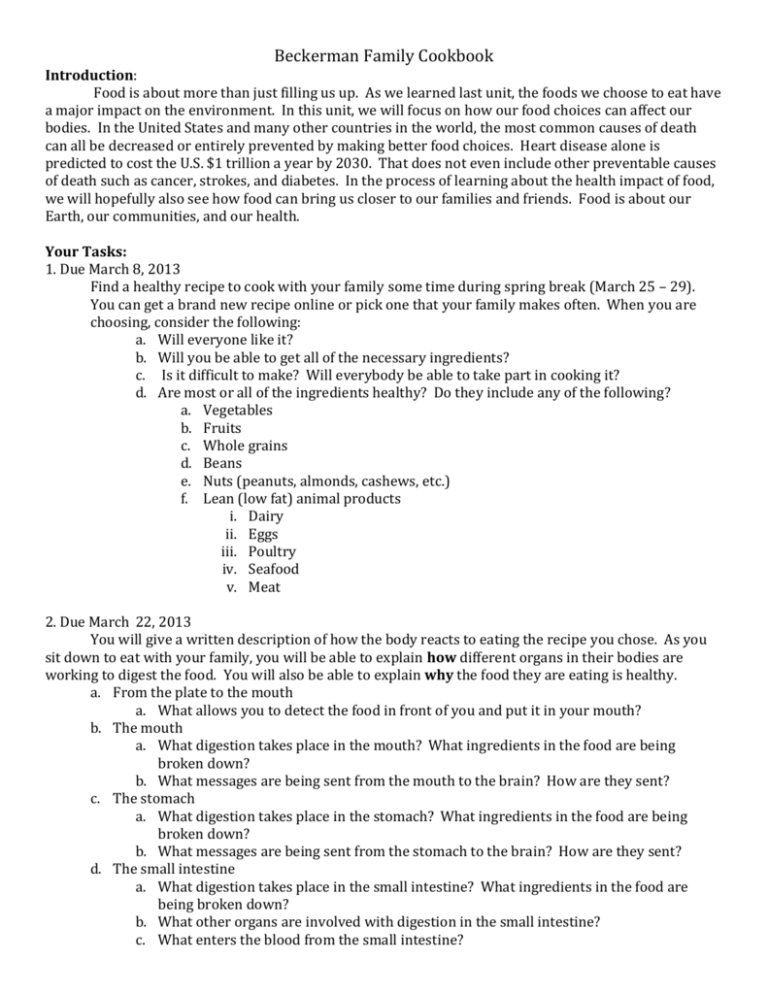
Beckerman Family Cookbook Introduction: Food is about more than just filling us up. As we learned last unit, the foods we choose to eat have a major impact on the environment. In this unit, we will focus on how our food choices can affect our bodies. In the United States and many other countries in the world, the most common causes of death can all be decreased or entirely prevented by making better food choices. Heart disease alone is predicted to cost the U.S. $1 trillion a year by 2030. That does not even include other preventable causes of death such as cancer, strokes, and diabetes. In the process of learning about the health impact of food, we will hopefully also see how food can bring us closer to our families and friends. Food is about our Earth, our communities, and our health. Your Tasks: 1. Due March 8, 2013 Find a healthy recipe to cook with your family some time during spring break (March 25 – 29). You can get a brand new recipe online or pick one that your family makes often. When you are choosing, consider the following: a. Will everyone like it? b. Will you be able to get all of the necessary ingredients? c. Is it difficult to make? Will everybody be able to take part in cooking it? d. Are most or all of the ingredients healthy? Do they include any of the following? a. Vegetables b. Fruits c. Whole grains d. Beans e. Nuts (peanuts, almonds, cashews, etc.) f. Lean (low fat) animal products i. Dairy ii. Eggs iii. Poultry iv. Seafood v. Meat 2. Due March 22, 2013 You will give a written description of how the body reacts to eating the recipe you chose. As you sit down to eat with your family, you will be able to explain how different organs in their bodies are working to digest the food. You will also be able to explain why the food they are eating is healthy. a. From the plate to the mouth a. What allows you to detect the food in front of you and put it in your mouth? b. The mouth a. What digestion takes place in the mouth? What ingredients in the food are being broken down? b. What messages are being sent from the mouth to the brain? How are they sent? c. The stomach a. What digestion takes place in the stomach? What ingredients in the food are being broken down? b. What messages are being sent from the stomach to the brain? How are they sent? d. The small intestine a. What digestion takes place in the small intestine? What ingredients in the food are being broken down? b. What other organs are involved with digestion in the small intestine? c. What enters the blood from the small intestine? e. The large intestine a. What enters the blood from the large intestine? b. Why is the large intestine important for maintaining homeostasis? f. Nutrients in the blood a. What happens to the carbohydrates from your food? b. What happens to the fats from your food? c. What happens to the proteins from your food? d. Why is your recipe healthy? g. Homeostasis a. How do the processes you described above allow your body to maintain homeostasis? b. Why are the foods you chose healthy for your body Beckerman Style Oatmeal Ingredients: - 1.5 c organic rolled oats - 1 tsp cinnamon - 1 tsp cocoa powder - 1 tsp ground flax seeds - ¼ c raw cashews - cold water Instructions: 1. Pour all ingredients except water into serving dish. 2. Add cold water until it reaches the level of the top of the ingredients. 3. Eat. _________________________________________________________________________________________________________________________ 1. From the plate to the mouth Even before you sit down to eat, your empty stomach causes the release of ghrelin, which interacts with NPY in the brain to cause you to feel hunger. Light receptors in the eye detect light reflected by the food. That information is sent to the brain through sensory nerves. The brain then sends out the signals to the muscles of the arm through motor neurons to scoop up some oatmeal with a spoon and carry it to the mouth. 2. The mouth The brain sends messages to the jaw muscles through motor neurons to chew the food in the mouth. Chewing the food into smaller pieces is the first step in digestion. Sensory neurons attached to taste buds and the nose send information about the taste and smell of the food to the brain. In the mouth, the enzyme salivary amylase begins to break down starches. The oats in particular have a lot of starch which begins to be digested in the mouth. 3. The esophagus The food moves from the mouth into the stomach by passing through the esophagus. The chewed food is pushed through the esophagus by smooth muscles in a motion called peristalsis. Motor neurons carry messages from the brain to the muscles of the esophagus to carry out this action. Peristalsis is involuntary; you do not have to think about moving your food down your esophagus to make it happen. 4. The stomach When food enters the stomach, it causes the secretion of pepsin, which is an enzyme to break down proteins. The protein contained in the oats and cashews will begin to be digested here. After eating, the stomach and fat cells release leptin into the blood, which turns off the NPY signal in the brain to make you stop feeling hungry. Because this is not a meal high in fat or sugar, it will stimulate the appropriate leptin-NPY response so that you do not overeat. The stomach also contains stretch receptors. Sensory neurons carry the signal that your stomach is stretching to your brain to reduce your feeling of hunger. Because this recipe has a relatively low Calorie density (few Calories per gram), it fills up space in your stomach with fewer Calories, helping you to feel full without eating too many Calories. 5. The small intestine When the food enters the small intestine, any nutrients that have not yet been broken down chemically are digested. Amylase, trypsin, and lipase are enzymes released into the small intestine from the pancreas to break down starch, protein, and fat, respectively. The starch from the oats, the protein from the oats and cashews, and the fat from the cashews and flax seeds are all digested here. The small intestine itself secretes other enzymes to completely break down the carbohydrates and proteins from the food. Fat digestion is aided by bile, which is produced by the liver and stored in the gallbladder. Bile breaks up the fats into tiny droplets to be more quickly digested. When nutrients are completely broken down, they are absorbed into the blood through the wall of the small intestine. Tiny finger-like projections called villi provide plenty of surface area for nutrients to be absorbed into the blood. When the food reaches the end of the small intestine, everything has been absorbed except for water, cellulose, and anything that can’t be digested. There is plenty of cellulose in this recipe from the oats and flax seeds. All of this cellulose, also known as fiber, is very healthy for the digestive system and helps to keep you feeling full for longer, which is another way to prevent eating too much. 6. The large intestine The main function of the large intestine is to remove extra water from the undigested food that remains, preparing for excretion from the body. In order for the body to maintain homeostasis, it must excrete the appropriate amount of water and rid itself of waste, which are the main roles of the large intestine. Smooth muscles in the large intestine are responsible for moving the remaining food to the end of the digestive system. Messages to do this are sent through involuntary motor neurons. 7. Nutrients in the blood Carbohydrates that enter the blood from food are delivered to cells all throughout the body. After a meal, blood glucose levels increase, causing the pancreas to release insulin. Insulin, is the chemical message to move glucose from the blood into the cells. Once glucose enters the cell, it is broken down by the process of cellular respiration. The blood delivers the oxygen necessary to break down the glucose. The blood carries the carbon dioxide produced at the end of cellular respiration to the lungs to be exhaled from the body. Carbohydrates are the body’s number one source of energy. This recipe is an excellent breakfast because it is rich in carbohydrates, providing the body with plenty of energy. Fats that enter the blood have a number of different uses. They are used to make cell membranes, hormones, and the myelin sheaths that surround axons. Fat is also a form of longer-term energy storage for the body. The cashews and flax seeds are both excellent sources of healthy fats. Amino acids absorbed into the blood are the building blocks for all of the proteins that your body needs. The amino acids are transported to all cells in the body. DNA, which serves as the instructions for life, is really just instructions on how to make proteins. Everything in the body is made of or by proteins. The amino acids from food are rearranged into new proteins according to the instructions from your DNA. 8. Homeostasis The processes described above are necessary to provide the body with everything it needs. Carbohydrates provide energy, which the body is constantly using to stay alive. Fats provide energy and also make important parts of the body such as cell membranes. Without fats, there would be no cell membranes, which means no cells and therefore no life! Proteins are essential for everything that happens in the body. Waste products are removed from the body at all times. Carbon dioxide is exhaled through the lungs. Anything that cannot be digested is excreted from the body. Additionally, the kidneys filter the blood to get rid of excess salt, water, and waste products, such as urea, which are excreted through urine. This recipe provides the body with carbohydrates, fats, and proteins. It is low in unhealthy fats and sugar to prevent overeating. The high fiber also helps you to feel full for longer. Furthermore, this recipe is vegan, which has a very low impact on the environment. Eating this recipe is good for the body and the Earth. It’s also pretty cheap! Not bad! Unit 9: Anatomy and Physiology Standard 9a. Students know how the complementary activity of major body systems provides cells with oxygen and nutrients and removes toxic waste products such as carbon dioxide. 9b. Students know how the nervous system mediates communication between different parts of the body and the body’s interactions with the environment. 9c. Students know how feedback loops in the nervous and endocrine systems regulate conditions in the body. 9d. Students know the functions of the nervous system and the role of neurons in transmitting electrochemical impulses. 9e. Students know the roles of sensory neurons, interneurons, and motor neurons in sensation, thought, and response. 9f. Students know the individual functions and sites of secretion of digestive enzymes (amylases, proteases, nucleases, lipases), stomach acid, and bile salts. 9g. Students know the homeostatic role of the kidneys in the removal of nitrogenous wastes and the role of the liver in blood detoxification and glucose balance. 9h. Students know the cellular and molecular basis of muscle contraction, including the roles of actin, myosin, Ca+2, and ATP. 9i. Students know how hormones (including digestive, reproductive, osmoregulatory) provide internal feedback mechanisms for homeostasis at the cellular level and in whole organisms. CST 0-1 0–1 1 1 0-1 0 0 0 0



